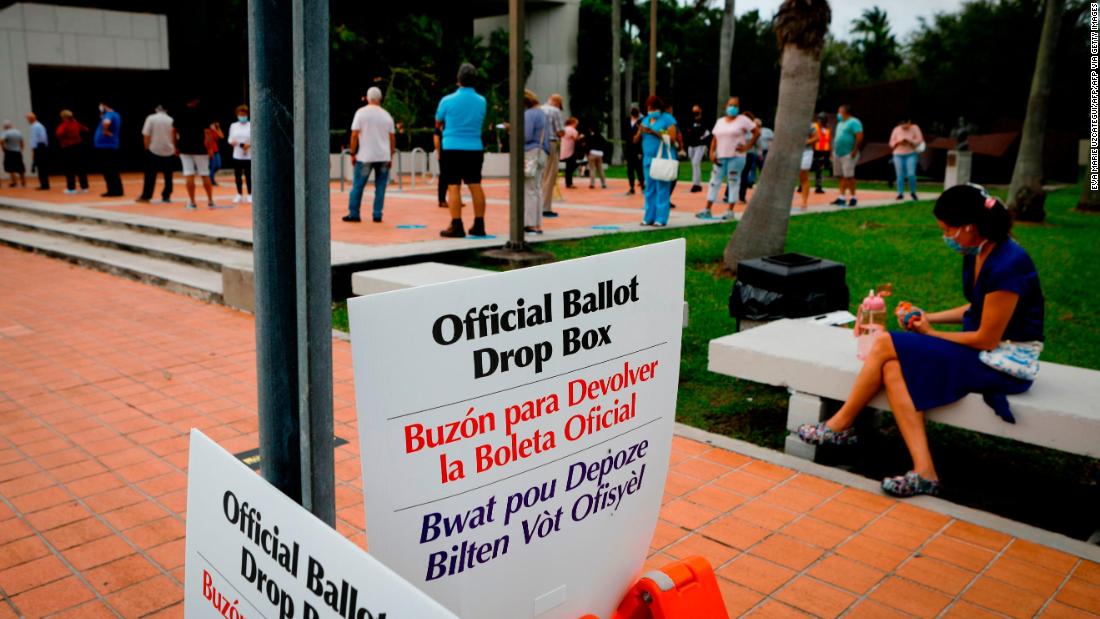These images are not proof of electoral fraud 3:08
(CNN) -
In four key states: Florida, North Carolina, Nevada and Iowa, Republicans are beginning to narrow the Democratic lead in the pre-Election Day voting.
Early voting
More than 12 million votes have been cast in these four states, which could be crucial in determining the next president.
Candidate agendas reflect the focus on these states.
President Donald Trump and former Vice President Joe Biden were in Florida on Thursday campaigning for the state's 29 electoral votes.
Later, Trump was scheduled to travel to North Carolina, while Vice President Mike Pence had scheduled campaign stops in Iowa and Nevada.
Biden is due to arrive in Iowa on Friday.
With five days until November 3, here's a deeper look at who has already voted in these key states, with data from Catalist, a company that provides data, analytics, and other services to Democrats, academics, and nonprofits.
Florida
Trump won Florida by just over one percentage point in the last cycle.
advertising
In the past week, voters under 30 have slightly increased their share of Florida's early voting electorate, from 8% to 10%.
Other age groups have also seen small increases, further diminishing the dominance of older Florida voters aged 65 and over.
These made up 45% of early voters a week ago, but now only 39%.
Florida's early voting electorate is slightly more diverse than four years ago.
Hispanic voter turnout in voting prior to Election Day has risen from 14% four years ago to 16% now.
And black voter turnout has risen slightly from 12% then to 13% now.
The vote of white voters is down three points since 2016.
Republicans are closing the gap in ballots cast before the election.
Democrats currently lead by four points.
A week ago, it was nine points.
The party advantage does not predict the outcome, but national polls show that many Republicans also prefer to vote in person on Election Day rather than early.
READ
: OPINION |
Trump's big problem in Florida
North Carolina
Trump won Tar Heel status by more than three percentage points in 2016.
Young people continue to vote in large numbers in North Carolina.
Last week, voters under 30 made up about 11% of early voters, but now that has risen slightly to more than 12%.
Democrats have lost some of their lead in the pre-election vote.
Last week, they had a 12-point lead over Republicans on the ballots cast.
Currently, it stands at eight points.
By race, white voters account for the majority of ballots already cast in North Carolina at 72%, followed by black voters with the second highest proportion of those ballots at 22%.
This remains nearly identical to the racial makeup of the early voting electorate four years ago.
Iowa
Iowa remains a competitive battlefield this cycle after Trump won Hawkeye status by more than nine percentage points in 2016.
The state also has a key Senate race between incumbent Republican Joni Ernst and Democratic rival Theresa Greenfield.
Democrats continue to vote before the election at a much higher rate than Republicans, similar to 2016. With 49% of the pre-election votes, Democrats have a 17-point lead over Republicans, who rank at 32%.
Republicans, however, have narrowed that gap slightly over the past week by four points.
By race, Iowa's current electorate before Election Day is similar to this point in 2016, with white voters comprising the vast majority of early voters at 94%.
Iowa has not seen as big a change in the age breakdown as some other states.
Voters under 30 make up 10% of all early voters, just three points more than four years ago.
Voters between the ages of 30 and 64 have risen five points from 42% of turnout four years ago to 47% now.
Voters age 65 and older make up a smaller proportion of early voters than they did now four years ago.
READ
: ANALYSIS |
Trump and Biden meet in the final sprint as the virus progresses
Nevada
Nevada had a narrow margin of defeat for Trump four years ago, with about two percentage points separating him from Hillary Clinton.
Nevada's early voting electorate tends to be younger compared to last week.
11% percent of voters so far are under 30 years old;
last week it was only 9%.
Voters 65 and older have gone from 40% of the first voters last week to 35% now.
About two-thirds of Nevada's ballots come from white voters, a small decrease from 70% from four years ago.
Hispanic voters make up the second-highest share of those ballots at 13%, a slight increase from 2016. Black and Asian voters have also seen increases of one percentage point in their early voting participation.
Republicans are reducing the Democratic lead in the pre-election vote.
Last week, Democrats outscored Republicans by 12 points.
Since more ballots have been returned in the vote-by-mail state, 42% of ballots cast by Democrats are now only seven points higher than 35% by Republicans.
early voting

